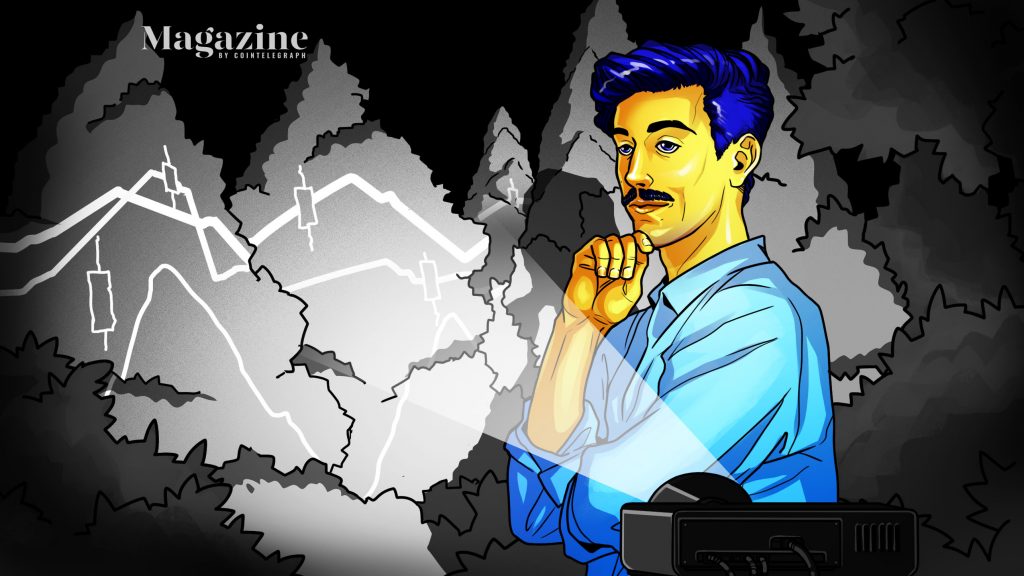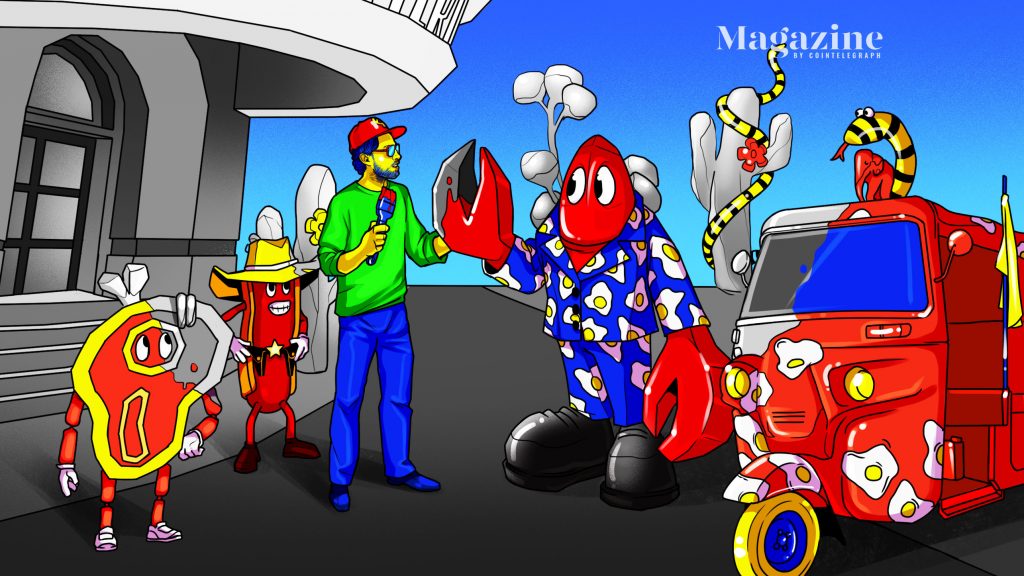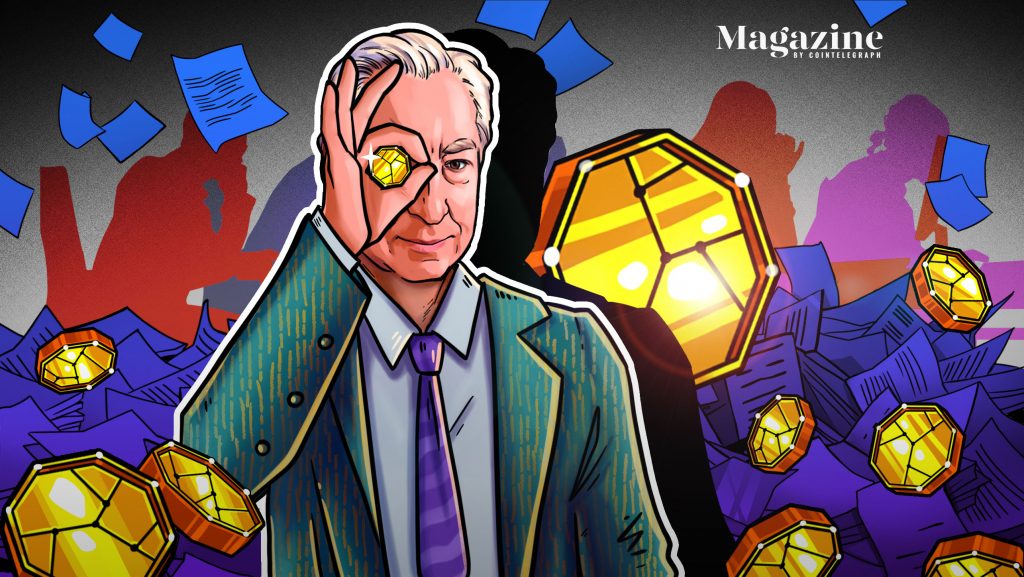Am I the only person who sees cryptocurrency charts when I shut my eyes, hovering just beyond the limits of my focus like an old TV set that’s been permanently burned in by a paused video game?
Am I alone in spotting elements of token names, logos and symbols in food packaging at the supermarket?
Or are you also catching fleeting glimpses of crypto candlesticks hidden among the everyday objects before you or just beyond the edge of your vision?
These neon mirages scorched into my retina, the byproducts of squinting endlessly at jagged crypto charts during long COVID-19 lockdowns, inspired my NFT series “The Crypto Effect.”
These blockchain-inspired works of visual art are my homage to the mental health rollercoaster on which decentralized finance took many of us during the coronavirus crisis and accompanying cryptocurrency bull run.
Our inability to leave our homes this past year, as if trapped in Edward Hopper paintings, was diametrically contrasted with crypto and decentralized finance’s explosive charge into the public consciousness.
As a visual journalist, I have recently been capturing the trickle-down effects of this Herculean revolution, using a projector to superimpose what I was seeing in my head last spring onto the world around me.
This ongoing photo-projection series, which currently incorporates charts and data from around a dozen different tokens, has so far taken me across two continents. I’ve projected Polkadot candles onto 300-year-old buildings in Barcelona; I’ve cast Litecoin prices onto the torsos of blockchain enthusiasts in small New York City walk-ups; I’ve covered coworking spaces near Boston with Aave data; and I’ve even lit up a forest near Canada with Stellar Lumen charts.
And now by taking direct requests on social media, I aim to craft more images around tokens that have been stirring in the minds of others.
But creating this first iteration of the series has also been an odd, unexpected form of personal therapy, having lost a rather hefty sum earlier this year due to my own shaky inexperience. And though my funds may have tanked, my enthusiasm for the larger decentralized finance movement has not.
Having spoken to many other investors glued to their screens during the past year, I know I’m not alone in seeing these phantom charts. So, why are some of us seeing crypto in the world around us when we step away from our computers? And why are we being haunted by these faint, floating lines and numbers?
Is this addiction? Is it infatuation? Insanity?
The answers to these questions actually have more to do with that paused video game I mentioned earlier than I would have ever imagined. Like many others in the media industry, I was grounded during the height of the pandemic, banished to tapping away on my laptop at home.
But instead of spending my free time doomscrolling or chatting with long-lost colleagues on Zoom, I was swept up by an international event of a different sort: a blockchain boom.
Having missed most of the 2017 surge, I traded crypto endlessly early this year, discussed the technology ferociously and lapped up every ounce of information I could find. I was green and going through the motions of my newest obsession.
Often exhausted by the day’s mental gymnastics, I’d go to bed buzzing, my brain full of numbers and frying like an egg in a pan freshly off the stove.
For years, immersion was a big part of my work — relocating to Asia, Africa or Eastern Europe for weeks or months at a time. But my infatuation with crypto quickly snowballed and became worrisome to those around me. The isolation of the pandemic was exacerbating my tendency toward tunnel vision, which is beneficial in the world of photography and filmmaking but problematic when trading one’s own cash.
And during some of those darker winter evenings under our brick Catalan ceilings at home in Spain, the charts and volume data from my last trades would visit me like phantoms in the room, fluttering and stinging the back of my mind’s eye, while my body thrashed anxiously around under the sheets next to my wife.
Wedge. That’s a falling wedge,” I’d mouth into the night. Was I whispering aloud? Was I dreaming, or was I awake?
Whether I made or lost hundreds that day — or even thousands — anxiety and excitement feel the same when you haven’t slept in days and a pandemic is snatching up friends just beyond your front door.
I still feel a debilitating sense of naivety when I think about all those I believed online who recited the crypto anthem: “We’re all going to make it.”
By late May, I was left with excuses to formulate, an empty wallet to consider and a new raging obsession that seemed to be spawning low-grade hallucinations.
Now safely on the other side and with my tunnel vision cast back upon my career, I’m excited to ask: What the hell was going on during those tumultuous months indoors? Like some of you in parts of Europe and America, I was shot back out into the streets rather abruptly in late spring, lucky enough to be flanked by vaccine tents, first responders and reopening restaurants. But the moody, dramatic lights of Catalonia flipped back on just as Ether and Bitcoin flipped out, their value plunging even as humans emerged from our enforced social hibernation.
During the height of the pandemic, the total value of cryptocurrencies saw a spiked increase from roughly $242 billion to about $2.43 trillion. And only shortly after, the market tanked by $1.3 trillion.
That’s a lot of money, yes. But more worrying to me was the number of real people behind those figures — families and bank accounts shaken by the volatility of the market.
One of the first meals outside our home was spent eating tapas and observing a friend and her mother peering anxiously at Binance charts on their respective phones.
Early this summer, Crypto.com estimated the number of crypto traders to be above 220 million, having doubled in a matter of six months. Looked at another way, one in every 35 people on planet Earth was trading cryptocurrency at one point this year. And many of us have begun seeing that figure play out on a local level.
This winter, from my studio in Barcelona’s Gracia neighborhood, I could hear the hoots, boos and caws normally reserved for FC Barcelona football being belted from a neighbor’s open balcony each time Ether jumped sharply.
But it wasn’t until the big dip on Tuesday, May 18 of this year, that the localism of these stats sunk in. That evening, I witnessed a group of well-dressed Spanish 30-somethings stumbling down Carrer de Francisco Giner, nursing their phones against their chests and bellowing over crypto’s swift plunge.
Though no significant statistics have been compiled on cryptocurrency addiction, a small study in Turkey recently found that out of 300 crypto investors polled, 2% displayed signs of gambling addiction.
If the figures from that humble study were extrapolated to represent the world’s 221 million traders, that would imply roughly 4.5 million crypto investors could be showing signs of gambling addiction.
That number needs to be taken with an enormous grain of salt, considering the poll’s size and geographic concentration. But for perspective, 4.5 million people is roughly a third of those who die each year around the globe from drugs and alcohol.
And why not use the analogy? The 24-hour market, the ease of accessibility, the never-ending rushes of adrenaline each time the market spikes — this all has an effect on our behavior and opportunities for addiction.
Across the Atlantic in the United States, where one in three people are now showing signs of clinical anxiety or depression, near-universal access to such addictive technologies has the potential to become seriously problematic. Crypto addictions are becoming so rampant that a commercial industry is forming around them. The treatment for cryptocurrency addiction is often similar to Alcoholics Anonymous, where patients are encouraged to begin a 12-step program, while in-patient treatment can cost into the tens of thousands.
“Crypto trading is very similar to day trading or gambling,” says Dylan Kerr, a private clinical addiction counselor.
And a 2019 report from the National Institutes of Health agrees, saying “Trading cryptocurrencies is strongly associated with problem gambling severity.”
Kerr, who is currently serving at a clinic in Thailand and often works on the frontiers of new addictions, warns that ever since 2018, he’s seen a tremendous spike in those seeking counseling for their crypto addictions.
But unlike more traditional counselors, Kerr takes Bitcoin as payment.
You might think that ironic, but I believe it speaks to his understanding of the permanence of the issue he’s addressing. After all, which currency do you think those trading the U.S. dollar on Wall Street use to pay their therapists and counselors?
“I see it as a valuable asset,” he adds, noting that “Cryptocurrencies are very necessary economic items for the redistribution of wealth, especially for millennials.”
“These [his clients] are often novices who got lucky and hit it big quickly,” Kerr specifies.
And as for my chart-infused dreams, he agrees — from his desk in Thailand — that my seeing these crypto mirages may have been a sign of an approaching addiction.
“I’ve heard about these dreams before. It’s the product of obsessional thinking,” he says.
This is not new information, however. In fact, even the cryptocurrency rehabilitation program that opened at Castle Craig Hospital in Scotland in 2018 is becoming a fixture in the blockchain community. The hospital now sports its own YouTube channel alongside crypto influencers.
Treatment centers in America are also beginning to think about cryptocurrency. The Maryland Addiction Recovery Center is seeing a wave of investor inquiries.
Zach Snitzer, co-founder of the recovery center in Maryland, explains that:
It is now becoming part of the lifestyle of abuse. There is drug abuse, gambling abuse and issues around trading cryptocurrency. They are now a part of the larger tapestry of behavioral health.
“It snowballs. It becomes less about the money they are making than the rush of emotions they are feeling from that behavior,” he adds.
Questions around crypto addiction and the habit of near-constant checking of prices are also mooning this year on Reddit.
A quick search will reveal a thread emblazoned with the question: “Is anyone else dreaming about the charts and checking their crypto portfolios when they first wake up?”
Another post, which received over 800 comments, was prompted by the query: “Anyone else got majorly addicted to checking your phone every 10 minutes when they just started with crypto?”
One Redditor replied: “I dream of checking the phone just to wake up and go check the phone.”
Another simply posted: “Ur new?”
Nailed it. Whether working in visual innovation or merely acting as a reporter, I’ve made a career out of diving headfirst into ideas that I know nothing about.
The fresher, more complex the puzzle to be solved, the more I dig into it, going from unknown to known. And if I’m lucky, I’m gifted a day-long adrenaline rush and some unusual dreams in return for my services.
When I was starting out, I worked as a breaking news journalist — a job that had me writing up to six news stories a day. On top of that, the pressure to catch every word in a presidential press briefing, for example, can be mind-bendingly intense and require such inconceivable attention. The only comparison I could draw would be day trading cryptocurrencies.
And like crypto, my work would often visit me late into the night. Once in bed, I’d feel a cursor blinking just beyond my peripheral vision, or I’d see foggy headlines being written and rewritten so that they didn’t bust through their character limits.
U.S. president seeks deal with Iran on….” Delete, delete, delete. “President calls for trust with Iran on…” Was I asleep? Was I whispering to myself? The questions were the same then as they are now.
Even picking up a box of cereal at the grocery store during that time could trigger feelings of computer keys being smooshed between my fingers.
As I learned back then, what I was experiencing had ties to the so-called “Tetris effect.”
You see, when Tetris was released in the 1980s, people were so hooked on Russian-American engineer Alexey Pajitnov’s video game that they’d see and hear it in everything they did.
One writer for Wired in the early 1990s even called the game a “pharmatronic” in reference to its addictive powers.
Journalist Jeffrey Goldsmith wrote of playing the game: “Days, I sat on a lavender suede sofa and played Tetris furiously. During rare jaunts from the house, I visually fit cars and trees and people together.”
Sound familiar? Seeing crypto candlesticks, anyone?
Pajitnov told Wired: “You can’t imagine. I couldn’t finish the prototype! I started to play and never had time to finish the code. People kept playing, playing, playing. My best friend said, ‘I can’t live with your Tetris anymore.’”
Tetris dreams became widespread fodder for conversation among gamers and psychologists alike. In fact, psychiatry professor Robert Stickgold and colleagues of his at Harvard Medical School found that of those they trained to play the game, more than 60% reported dreaming of images associated with it.
Stickgold argued that these Tetris dreams were simply part of how human beings process information from our waking hours.
Tetris has also been linked to the “flow state,” the name given to the groove you achieve when you focus so heavily on a goal that the world around you melts away.
Kerr agrees that the crypto visions I had, mostly late at night, sound like the Tetris effect. But he’s quick to point out that our brains will gravitate toward puzzles, no matter what they are.
“We are natural problem solvers. And crypto is like a big puzzle in some ways. Dreaming has been linked to problem-solving abilities. And crypto is a problem we want to solve and get right and make money from,” Kerr says. The promise of cryptocurrency is a more decentralized distribution of wealth, where power isn’t held by a select few. We know this. But I think about these implications often and elsewhere, even in journalism itself.
Advertising fills executive pockets at news institutions, in America especially. And if there was a more decentralized funding model, might there be less pandering to a political base on cable news? Might there be more information and less sensationalism? Might the result ultimately look more like the nonpartisan institutions gracing the airwaves across the pond? I believe so and am encouraged by blockchain to help find solutions to these broader systemic problems.
So, in the same way that melding journalism with my new cryptocurrency passion through this photo series has offered me a new way to humbly contribute to the blockchain movement, I see blockchain contributing to my journalism career through these crucial ideas.
And these reassurances have allowed me to begin trading again — more thoughtfully and carefully, paying far less attention to crypto and limiting it only to my free time. And thankfully, the charts are not visiting me in the same way they once were.
Free of lockdowns for the moment and once again navigating the outside world, there are more interesting puzzles to be solved.
My photo series was the culmination of my months-long infatuation with crypto. But my addiction, if you can call it that, was also partly the result of seemingly unending bouts of isolation.
Hallucinations notwithstanding, the loneliness many of us felt during the past year, closed off from society, left alone with charts and pixels, peering at TradingView, often utterly alone — that wasn’t, and isn’t, healthy.
But in some way, it gave us focus. Our flow states saw some of us through a worldwide crisis that claimed millions of lives.
And if you’re reading this today, I’m happy to report that the so-called Crypto Twitter influencers were right when they said: “We’re all going to make it.”
We all did in fact make it — just maybe not in the way that you or I were expecting.
Some made it by trading altcoins and earning significant returns during the past year. Others made it by simply coming out of the other side of this global crisis with their physical and mental health in tow.
And as for me, I’m just so appreciative to represent the latter of those two camps.
If you believe you are suffering from cryptocurrency addiction, there are groups — primarily for-profit, such as those mentioned above — providing direct treatment services. For a more comprehensive list of free or reduced-cost services, however, the U.S Department of Health and Human Services has a number of hotlines and other services available for gambling addiction. https://www.samhsa.gov/find-help/national-helpline
Bringing contemporary pop art to an NFT metaverse
“The digital side of my work has been very much a labor of love — I have been building this infrastructure for some time.”
Read morePowers On… Insider trading with crypto is targeted — Finally! Part 1
“It took a few years, but government crackdowns on ‘insider trading’ involving digital assets have finally arrived. It’s about time!”
Read moreBitcoin ‘bull pennant’ eyes $165K, Pomp scoops up $386M BTC: Hodler’s Digest, June 22 – 28


